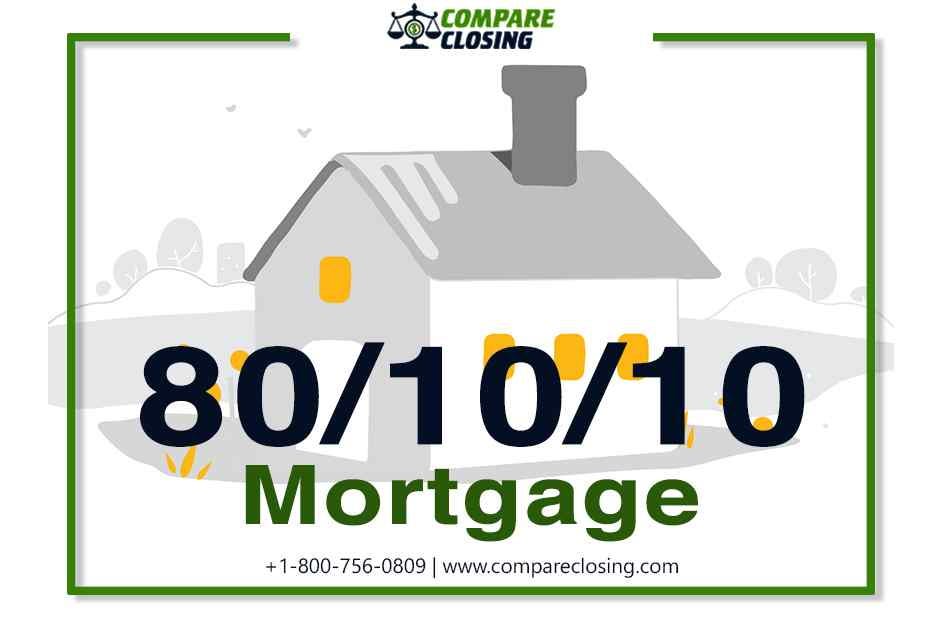
What Is an 80–10–10 mortgage?
When first and second mortgages are obtained simultaneously in a loan it is called 80–10–10 mortgage.
The primary mortgage lien is taken with 80% of the home’s cost hence it is an 80% loan to value ratio (LTV ratio), the secondary mortgage lien has a 10% loan-to-value, where the borrower makes a down payment of 10%.
This arrangement is very different from the traditional single mortgage with a down payment amount of 20%. The 80–10–10 mortgage is similar to a piggyback mortgage.
Knowing More About The 80–10–10 Mortgage
Anytime a prospective homeowner buys a home by putting in less than the standard 20% down payment, they have to pay for private mortgage insurance (PMI).
The PMI insurance protects the financial institution or the lender lending the money against the risk of the borrower backing out on the payment of the loan.
Borrowers who want to avoid paying PMI, because it makes their monthly payment higher, regularly use 80–10–10 mortgages.
80–10–10 mortgages are more popular in times when the home prices are rushing up. As homes become less affordable, it might become difficult for an individual to make a 20% down payment of cash.
These mortgages allow buyers to borrow more money than their down payment might suggest.
The primary mortgage of an 80–10–10 is usually always a fixed-rate mortgage.
Whereas the secondary mortgage usually is an adjustable-rate mortgage like the home equity loan or the HELOC, ie. home equity line of credit.
What Are The Advantages Of An 80–10–10 Mortgage?
The secondary mortgage acts like a credit card, but with a lower interest rate because the equity in the home is backing it.
The loan only incurs interest when the borrower uses it. Meaning the borrower can pay off the home equity loan or HELOC in full or in part and avoid the interest payments on those funds.
And once settled, the HELOC credit line remains. These funds then can act as a reserve pool for other expenses, like home renovations or even further education.
An 80–10–10 loan is an ideal option for people who are trying to buy a home but have not yet sold their existing home.
In such situations, they would use the HELOC to take care of a portion of the down payment on the new home. And when the old home sells they would pay off the HELOC.
The conventional mortgage interest rates are lower than that of the HELOC, which will somewhat nullify the savings gained by having an 80% mortgage.
But if the borrower pays off the HELOC within a few years, this might not be a problem.
The homeowner’s equity will increase along with their home’s value when home prices are rising.
But in case of a housing market downturn, they could be left dangerously at loss with a home that’s worth less than what they owe.
What Are The Disadvantages Of An 80–10–10 Mortgage?
The adjustable interest rates on the second loan: The interest rate for the first mortgage usually is fixed.
But the interest rate of the second mortgage or home equity loan is a higher rate and is usually variable so it keeps changing with the level of interest rates in the economy.
During a period of rising interest rates or inflation, this variable interest rate can be disadvantageous, because when the rate rises, so will the loan costs.
Difficulty in refinancing: The 80–10–10 loan is difficult to refinance because if both the primary and secondary mortgage lenders are different they have to agree to the refinancing.
It would be difficult to convince both lenders to refinance if the value of the home has declined.
Example of an 80–10–10 mortgage
If a family wants to purchase a home for $200,000, and they have made a down payment of $20,000, which is 10% of the total home’s value.
They will need to pay PMI over and above their monthly mortgage payments if it is a conventional 90% mortgage. The 90% mortgage will also generally carry a higher interest rate.
Instead, if the family can take out an 80% mortgage at a lower interest rate, for $140,000, and avoid the need for PMI.
At the same time, they can take out a second mortgage of 10% for $20,000. Which could be a HELOC.
The down payment will still be 10% but the family has completely avoided PMI costs, got a better interest rate, and as a result have lower monthly payments.
Conclusion
During the housing boom, the growing home prices and lenient underwriting standards made 80–10–10 types of loans widely available.
An 80–10–10 mortgage is designed with two mortgages — the primary being a fixed-rate loan at 80% of the home’s cost; the secondary being 10% as a home equity loan; and the balance 10% as a cash down payment.
These mortgage plans reduce the down payment of a home without the borrower having to pay private mortgage insurance (PMI), and thus helping home seekers to obtain a home more easily with the up-front costs.
The borrowers however will have to face comparatively larger monthly mortgage payments and if interest rates increase they may have higher payments due on the adjustable loan.
https://www.compareclosing.com/blog/what-is-an-80-10-10-mortgage/
Comments
Post a Comment